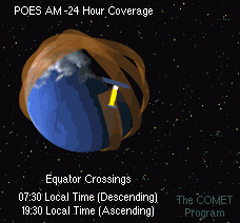|
|
NOAA operates two different types of environmental satellites that carry remote sensing instruments. Some of the satellites stay fixed above a certain spot on the Earth's equator: these are called geostationary satellites (GOES). The other kind orbits around the earth, passing close to the north and south poles on each orbit many times a day: these are called polar-orbiting satellites (POES). Geostationary satellites stay in the same position relative to Earth, so they can take frequent measurements of the same area throughout the day and night. However, each satellite can only see a fraction of the Earth's surface. Because coral reefs are located all around the world, Coral Reef Watch decided to use NOAA's polar-orbiting satellites to develop its heritage suite of 50km satellite coral bleaching monitoring products (discussed in subsequent tutorial chapters). Although polar-orbiting satellites can only measure a given area once or twice a day, they have the advantage of taking measurements around the entire planet.
|
|
||||||||||||
|
|
||||||||||||||
|
IMPORTANT USER ALERT (2 July 2024): This past weekend, a storage server at NOAA's Center for Satellite Applications and Research, which delivers the NOAA Coral Reef Watch data, suffered a hardware failure. The issue is being addressed, and we hope to have the NOAA Coral Reef Watch data back up and running as soon as possible. (1) The most recent data will be made available first; historical data may take time to be restored. (2) If you need specific data that are not yet available, please contact us at coralreefwatch@noaa.gov. (3) If you use code to pull data, please revise your code to use “…/socd/…” in lieu of “…/sod/…” in all relevant web addresses for all future needs. We apologize for any inconvenience this may cause. |
